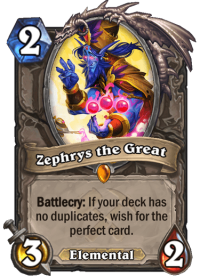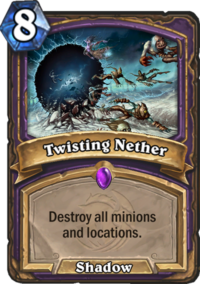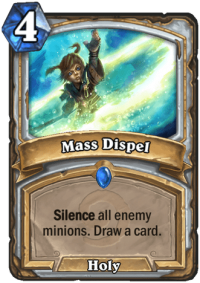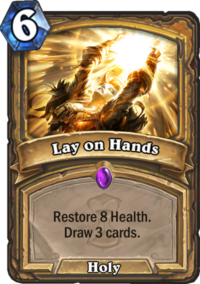
By far the most exciting card from the Saviors of Uldum set is Zephrys the Great, a minion that has really pushed the envelope on what’s possible in a digital card game like Hearthstone. It’s the neutral Highlander support tool for the expansion, a vanilla 3/2 for 2 mana which gives you a chance to discover the perfect card for your specific situation as long as the no-duplicates condition is met. You’ve probably known this already though – what you might not have figured out just yet is how exactly the card selection algorithm works for Zephyrs and how you can best manipulate it to your benefit! Here’s a set of handy observations based on the first two days of community play which will help you get the most out of Hearthstone’s Jolly Joker.
While Zephrys the Great only pulls from the Basic and Classic sets, that’s still a massive pile of potential options to keep track of. Luckily, the “best” cards for different scenarios often tend to fall into similar categories, so a set of baseline conditions can go a long way if you’d like to know when and what to expect from the dizzying djinn.

In most cases, you’ll be using Zephrys as a removal tool: for board clears and specialized AoE effects, it will try to destroy every enemy minion with the amount of mana you still have left after playing it, and in most scenarios, it’ll get the job done. For ten mana, you can guarantee a full clear (Deathrattles notwithstanding) with Twisting Nether. As a gameplay tip, Zephrys can be worth playing very early against Murloc decks due to the one-mana board flip option provided by Hungry Crab – you won’t always want to keep it for that perfect board clear later down the line, depending on your hand and your opponent’s deck composition.
If you can’t quite clear the entirety of the enemy’s board even with the perfect card, you need to make sure you have a good understanding of the way Zephrys prioritizes the different minions. As it turns out, the algorithm is not quite sophisticated enough to figure out that certain ones are extra important – in fact, this is something the developers explicitly confirmed in the explanation for their August 8th hotfix, stating that “normally Zephrys does not recognize minion effects”, but they’ve made a specific exception to teach it about Doomsayer. Playing it on turn six to a board with a stealthed Spirit of the Shark, an EVIL Miscreant and a bunch of Lackeys (a fairly common scenario against Rogues) will not give you a Hellfire because it isn’t a full clear. Instead, I was offered a Swipe and a Flamestrike in this particular scenario alongside a Taunt minion: the first spell instantly removes all damage from the board and the second one guarantees a clear the following turn.

This, alongside trying to remove the highest-health enemy minion, are the benchmarks Zephrys has to work with – and if that’s not possible, stalling options like Blizzard, Frost Nova or Earth Elemental come next on the chain. (Make sure to keep Mass Dispel in mind as a disgustingly good option in certain matchups!) It seems like won’t understand that the Sorcerer's Apprentice is a bigger threat than the Chillwind Yeti against a Mage deck if it has to choose between removing the two at a given point in the game.
For transformation-based removal effects, it seems to prioritize Hex over Polymorph when lethal damage doesn’t present itself otherwise. This might matter in certain edge cases where you really don’t want the Taunt to stick around.

Since Zephrys only considers your remaining mana and the board state, it’s exceedingly difficult to coax out some card draw from the “perfect card”. (It also won’t offer Youthful Brewmaster or other ultra-shenanigan-y cards that would allow you to play it again.) If you’ve already managed to stabilize but really want a heal effect, 8 is the most you can expect, either via Lay on Hands or Healing Touch. If you want to get the latter, make sure you spend your excess mana on something or else Zephrys will prioritize cards like Guardian of Kings or Truesilver Champion on an empty board, which may not be desirable against burn-based decks.
If you’re trying to gain some value on an empty board, it seems like you’ll always be offered Tirion Fordring on ten mana. For board-based lethal opportunities, always keep Savage Roar and Bloodlust in mind. The Druid spell will offer more damage with one minion on board, the same with two (but for cheaper) – otherwise, Bloodlust has the higher cap. Because of its lower mana cost and higher number of buffed targets (so you can e.g. punch a small Taunt with your Hero), Savage Roar will be better in many cases.
It has to be mentioned that the algorithm for Zephrys is not 100% foolproof even with the baseline calculations: based on this Reddit thread and this YouTube video, it seems to sometimes fail to account for the fact that you’ve already used your Hero Power when looking at lethal options, and it’s a known bug that it fails to offer Bloodlust when you have 0-mana tokens (like, quite ironically, Shaman’s Totems) on the board. The latter was fixed in the aforementioned August 8th hotfix alongside certain cases with enemy Divine Shields and the Poisonous keyword. That said, Zephrys is an excellent card and a wonderful way to leverage Hearthstone’s digital nature – so go ahead and make a wish!

Does zephrys know that i have cast preparation spell and i can cast other spells for 2 mana less and provide me with a 2 mana more spell which gives me lethal ?
I recently noticed another wierd missed lethal by Zephrys. While opponent was at 14 health and I had 9 mana, I played buffed Leeroy to 7 attack, attacked with it and followed with Zephrys which wierdly didn’t give me Windfury with 2 mana remaining. Was that some kind of bug or order issue? My only reasonable explanation is that I should have played Zephrys before first Leeroy attack (so Leeroy is still in green, marked as being able to attack) and thus Zephrys would give me Windfury for lethal. It seems that Zephrys doesn’t take into account minions that aren’t marked with green, which I suppose was the issue with 0 attack minions that was said to be fixed. However that’s only my theory so I am not 100% sure.
Just to clarify the specific interaction. I tested Leeroy-Zephrys interection with reversed order and it works the way it is supposed to (it gave Windfury for lethal). My conclusion is that it doesn’t take into account minions that already attacked and are thus not marked in green.
I’m playing highlander rogue. I had a shadowstepped zephrys in hand and put opponent down to 8. I had 9 mana. It did not offer me King Krush, instead of Pyroblast which I couldn’t play that turn. What gives?
They should let him take in account What you have in hand aswell..
I hope for the next expansion they design a card, a minion that reads ‘your opponents play with there hands revealed’
Would be a cool card to be a Dragon.
And a reference to a new format.
*their
You say you will use it for a clear most often, but that entirely depends on your deck type. Unlike reno, Zephrys can be a very strong payoff for an aggro deck, which doesn’t want board clears, but loves to use him to find lethal, or a little more burn. Just thought it was worth noting.
That’s very true, Zephrys lethals can be scary and are super consistent. The problem is that Aggro decks doesn’t want to build a singleton deck because of consistency issue.
I’ve actually seen someone running Tempo Rogue with Zephrys, but it was a regular build. Zephrys was there as just a 3/2 in the early game and then potential lethal in the late game, especially after Myra’s. Is it the right approach? Not sure, but it’s definitely interesting to see him being used in a regular, aggressive deck.
The break-even point on Bloodlust vs. Savage Roar is actually 2 minions: +2 attack to 3 targets = +3 attack to 2 targets, so Bloodlust gives you more damage with 3 or more minions.
Thanks, you’re right, fixed it.